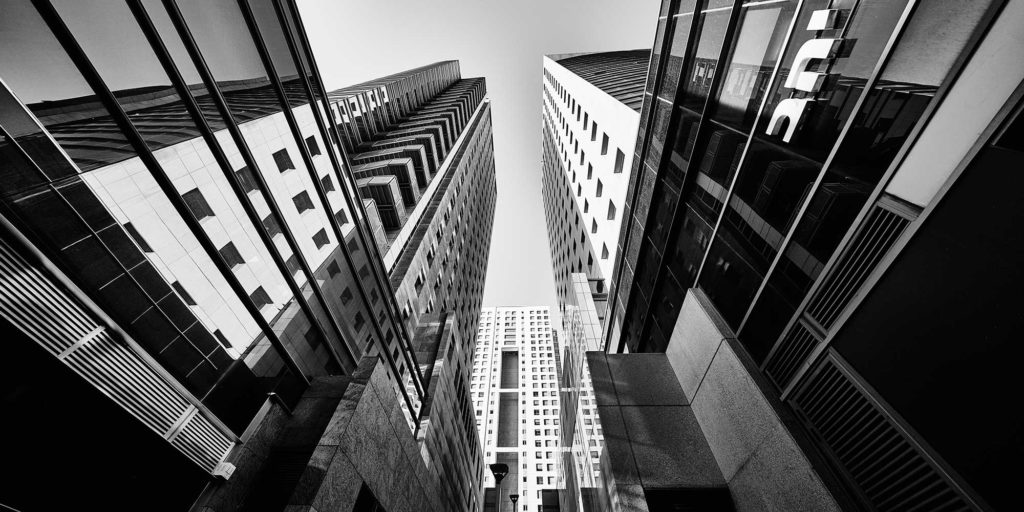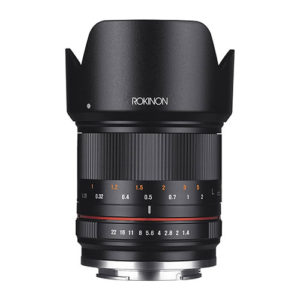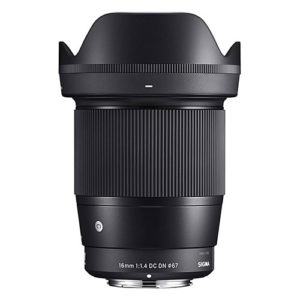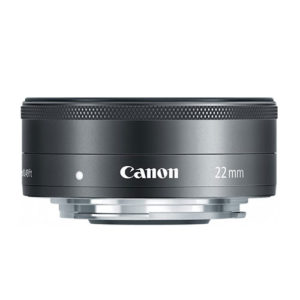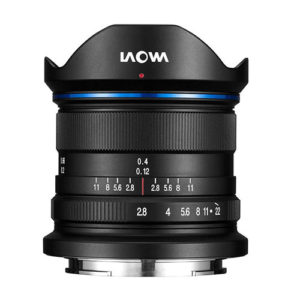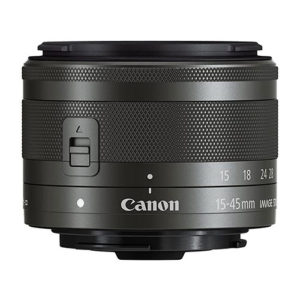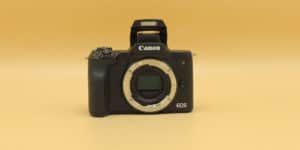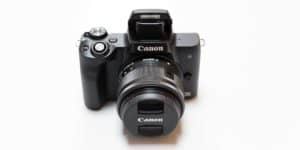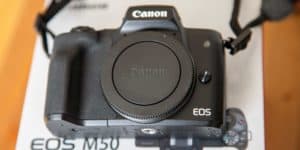Along with its newborn sibling, the M50 MKII, Canon’s M50 is currently one of the most popular consumer Mirrorless models out there.
Yet the M-mount range of lenses is still somewhat limited. Especially if you stick only to Canon’s native offerings.
This can make choosing the right wide angle lens for your M50 something of a challenge.
In order to aid you in your quest, I begin this guide by listing what I believe to be seven of the best M-mount wide angle lenses available right now – both native Canon offerings and options from third party manufacturers.
I then dig deeper into discussing the most important points to consider when choosing a wide angle lens for the Canon M50, whatever your photographic interests might be.
Okay, so let’s get the controversial part out of the way first: this lens doesn’t offer autofocus. You have to set focus manually.
I know, I know; not everyone will agree with my decision to make a manual-only lens number one on this list. But I don’t intend these guides to serve as a rigid ranking anyway.
Of course, the order in which I list lenses is intended to reflect their approximate degree of quality and usefulness.
But the fact is that every photographer has different requirements. And if the Samyang/Rokinon 21mm f/1.4 doesn’t meet your precise needs for some reason – lack of autofocus or any other – hopefully you’ll find something further down the list that does.
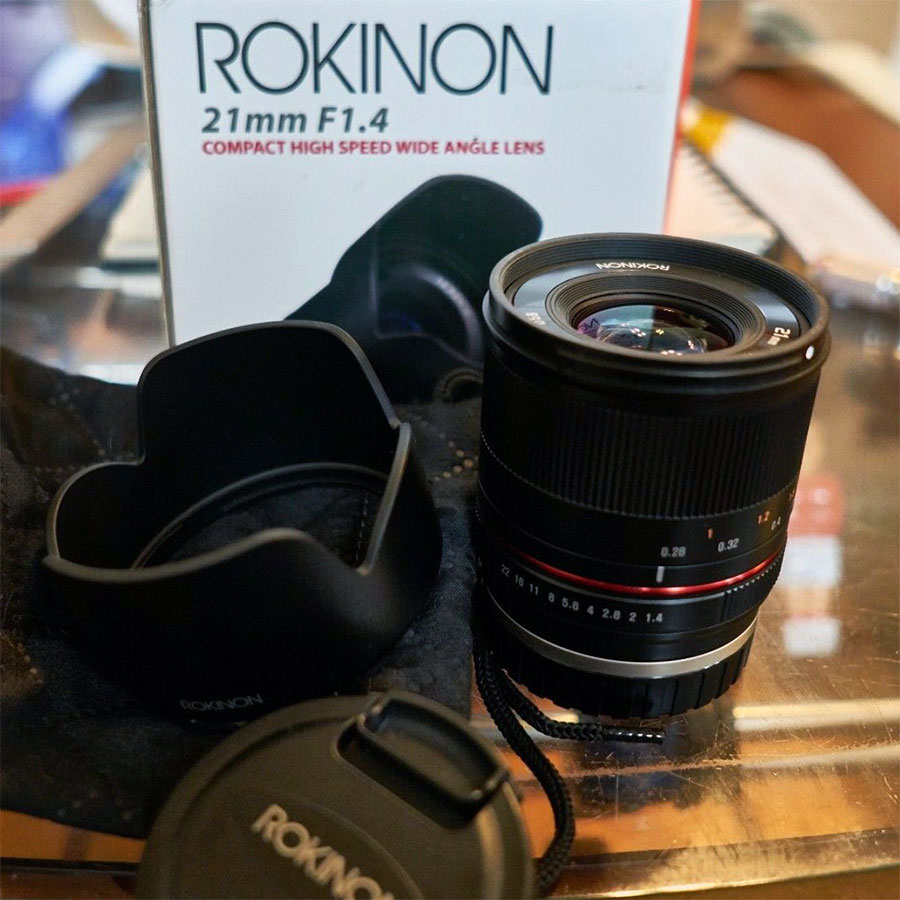
With that out of the way, let me tell you why I believe that this lens deserves to occupy the #1 position in this guide to the best wide angle lenses for the M50, despite the lack of AF.
To start, offering an angle of view equivalent to a 33mm lens on full frame, 21mm is simply a very useful focal length – not too short, not too long.
And if you’re in the market for a single wide angle prime for the M50, a lens of 21mm or thereabouts is probably the most versatile you could go for.
Admittedly this opinion is largely subjective. But I’m certainly not alone in preferring a more moderate wide angle lens over the very dominant look of ultradwides.
They just encourage a more gimmick-free approach to photography.
The main reason I rate this lens so highly, though, is a combination of image quality and usability.
It’s simply a pleasure to shoot with. And the results are always surprisingly good for such a small lens (and on what is also a relatively small sensor).
The level of detail is incredible, contrast is excellent, and the colors are always a delight to see.
Of course, part of what makes the Samyang/Rokinon 21mm f/1.4 so usable is the beautifully fast maximum aperture.
For some reason most of Canon’s own M-mount lenses come with really mediocre specs in this department.
And for more impressive light-gathering abilities it’s often necessary to turn to third party brands. But even among these you’ll struggle to find many options as fast as f/1.4.
Not only does this permit shooting in lower lighting conditions, but of course makes it easier to achieve a shallower depth-of-field.
What’s more, nine rounded aperture blades make for very attractive out of focus backgrounds. It’s definitely a lens that excels at wider aperture settings.
Less positively, the lens is largely made of plastic, and I’m going to count this as a drawback accordingly.
However, as plastic lenses go, it seems reassuringly sturdy; this is not some rattling piece of toy-like junk. It also looks pretty good to the eye (not that this will make the slightest difference to your photos, of course).

Continuing with the nitpicking, there’s some vignetting at wider apertures. But that’s pretty standard to be honest, and easily corrected with software.
And the only other optical defect worth noting is a touch of barrel distortion – but the Samyang/Rokinon 21mm actually performs much better than most similarly specced lenses in this department.
To sum up, this is simply an optically excellent lens that produces great looking images.
If you shoot landscapes, documentary, street photography, interiors, fashion, events, or a whole host of other genres – and can live without AF – the Samyang/Rokinon 21mm f/1.4 should be high on your shortlist of prospective wide angle lenses for the M50.
Providing an angle of view equivalent to 24mm on a full frame camera, the Sigma 16mm f/1.4 is a fantastic prime lens that will meet most photographers’ wide angle shooting needs.
Clearly one of the biggest draws of this lens is its fast maximum aperture of f/1.4; permitting both low light shooting and a degree of separation between background and foreground.
While you’re never likely to achieve a whole lot of bokeh action with a lens this wide – at least not without getting very close to your subject – those areas that are out of focus do at least tend to be attractively rendered.

Image sharpness is great, and so too are color and contrast. The only optical disappointments being heavy barrel distortion and a liberal dose of flare. On balance, though, neither strike me as serious handicaps.
Built from metal and premium grade plastic, the lens gives the impression of being highly durable.
Operation is a pleasure via the smooth manual focus ring, and AF performs brilliantly – in total silence too. The latter point making it an ideal choice as a video lens for the M50.
What’s the catch? Well, it’s not the smallest or most lightweight of lenses. And some people might grumble about the lack of image stabilization – but as the M50 body already offers IS, surely that’s just being greedy!
Otherwise there’s very little not to like here. On top of which, the Sigma 16mm already comes mounted for use with the Canon M50, so no adapter is required.
When people think of wide angle lenses, they typically have the more extreme end of the spectrum in mind; the dramatic perspectives of a 24mm lens and beyond.
Yet while such wide angles certainly have their uses, shorter lenses shouldn’t be overlooked.
Indeed, a lens providing an angle of view equivalent to 35mm on full frame – such as this 22mm f/2 specimen from Canon – is arguably a lot more useful than any ultra-wide one-trick-pony will ever be.
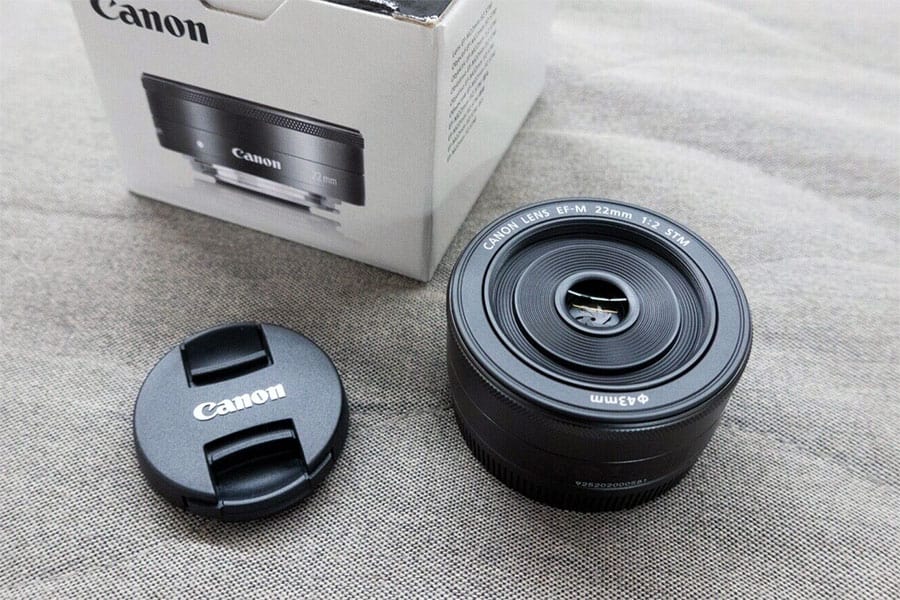
It depends on the genre of photography you have in mind, of course.
But a more moderate wide angle lens will often provide enough coverage to fit most scenes in the frame, yet without the heavy optical imprint of the lens itself – crazy perspective, converging parallels, tiny subject – getting in the way of the actual photography.
In short, a lens like the EF-M 22mm f/2 is a lot more “transparent” than its wider brethren. This makes it a great choice for photographers who prefer to place subject and composition at the fore, with technical trickery taking a backseat.
Add a fast maximum aperture of f/2 – something of a rarity among M-mount glass – and this is a lens that will appeal to everyone from documentary and street photographers to those shooting action sports, interiors, architecture, landscapes, and even astrophotography.
And for photographers partial to environmental portraits, 35mm is about as wide as you can go and still flatter the subject.
Autofocus performs well, with Canon’s impressive stepping motors resulting in smooth and silent action.
Manual focusing isn’t too shabby either; especially considering that it’s of the focus-by-wire variety.
Image quality is really where this lens shows its colors though. Files are sharp at the center – almost consistently so throughout the aperture range – with just a degree of corner softness when used at f/2. Admittedly there’s a noticeable amount of vignetting at the widest aperture, and flare could perhaps be better controlled, but distortion is basically non-existent. All in all, then, a very good optical performance.
Overall the Canon EF-M 22mm f/2 is a great multipurpose tool capable of earning its keep across a variety of photographic genres.
If you’re in the market for a bit of wide angle action but want something versatile for daily use, I see no reason not to go with this tasty little package.
True, there’s no image stabilization; but your M50 body has you covered here anyway. Recommended!
Let’s start by saying that this is a very good lens that comes with one major flaw, at least as far as many photographers will be concerned; a very slow maximum aperture. And not even a constant one at that.
Looking for a wide angle lens to shoot the milky way? Action sports? Poverty-porn social documentary projects in the world’s gloomiest slums where the inhabitants haven’t seen direct sunlight since 1997? This lens isn’t for you.
But should interiors, architecture, or landscapes – particularly landscapes – be more your thing, the EF-M 11-22mm f/4-5.6 is a great buy.
For a start, it’s a very compact and lightweight lens.
Making it ideal for minimalist backpacking in the great outdoors.
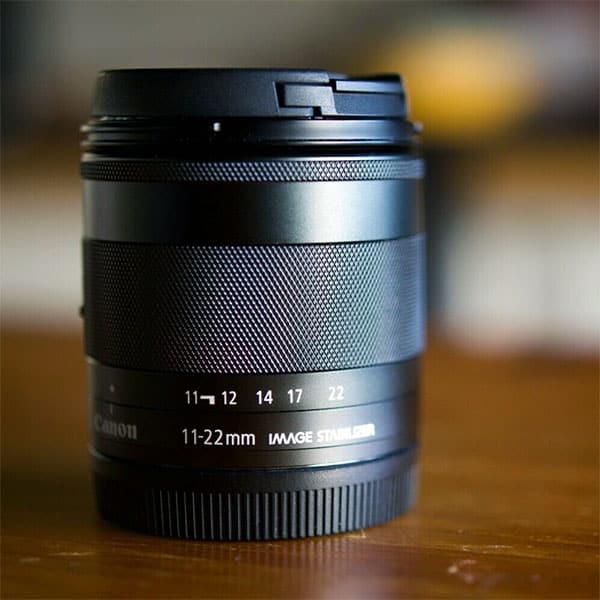
Then there are those capital letters in the name; IS STM.
The first stands for image stabilization. And while your M50 body already provides you with peace of mind in this department, there’s certainly nothing wrong with having an added degree of stability from the lens too.
Meanwhile STM signifies that this lens comes with Canon’s impressive stepping motors, resulting in very fast, accurate, and silent autofocus.
These two features combine to make the 11-22mm f/4-5.6 an excellent option for video.
Although, given the lens’s low light-gathering abilities, you’d be advised to provide your own illumination if you do go this route.
Above all, though, this is a lens capable of producing very nice quality images at a versatile spectrum of wide focal lengths.
Sharpness is great across the frame and throughout the zoom range, and you’ll only see a drop in precision after about f/11.
The one noticeable optical defect here is some heavy vignetting. But given how many photographers add a vignette effect to their images in Photoshop, this might actually be seen as an advantage by some.
In any case, vignetting is easy enough to remove in postproduction if you prefer a more neutral image.
This lens took the #1 spot in my guide to the best M50 lenses for landscape photography.
So why isn’t it in pole position here?
Well, it’s certainly a great lens. And for landscapes in particular it really shines. But there’s something you need to know about the Samyang/Rokinon 12mm; it doesn’t offer autofocus.
That’s right, this is an entirely manual lens; like they maketh in ye olden days.
Landscapes tend not to be going anywhere in a hurry. And in any case true manual focus is often more exact than the dreadful imitation of manual focus provided by most modern electronic lenses.
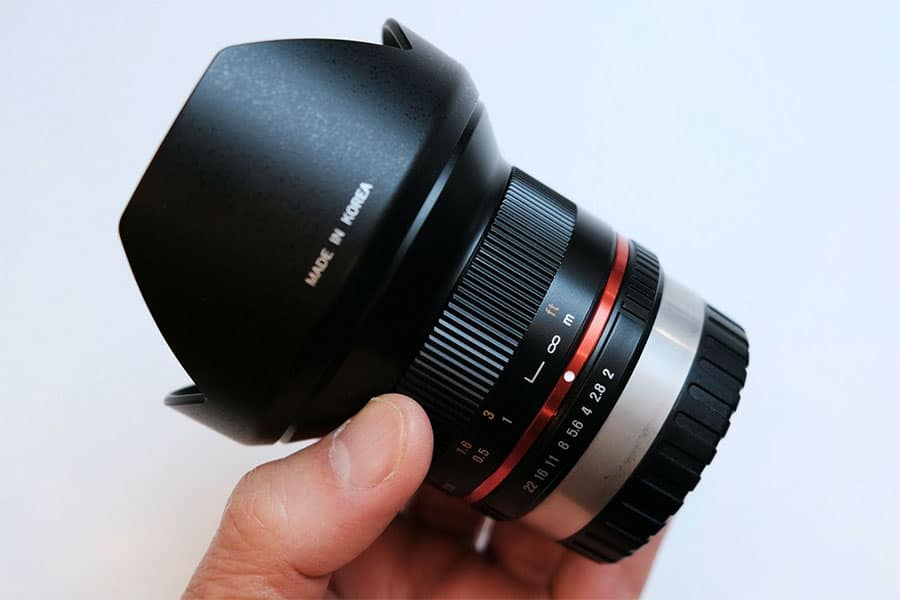
This makes an all-manual lens a perfectly good option for landscapes. And even for some portrait photographers, who might also prefer the precision of manual control.
It won’t be right for everyone though.
If you can live with this limitation (advantage?), however, the 12mm f/2 will be a very appealing option.
Especially for those seeking something sharp and reliable at the wider end of the scale (12mm is equivalent to an 18mm lens on full frame).
Image quality is superb, and the colors produced by this lens are very nice indeed. It’s also durably made in high-grade plastics and metal, and the focusing action is very smooth and tactile.
While most landscape photographers can take or leave a fast aperture, for those shooting portraits, documentary photography, or the night sky, a maximum aperture of f/2 is just what the doctor ordered.
Especially within a line of lenses where the fast aperture options are still quite limited.
To summarize, then, the Samyang/Rokinon 12mm f/2 is something of a niche lens. But if it coincides with your needs, it’s unlikely to disappoint.
Looking for a really wide lens? One with a wider angle of view than Canon’s native offerings can match?
And with a faster maximum aperture to boot? You probably need the Laowa 9mm f/2.8 from Venus Optics .
Admittedly it’s not the cheapest of M-mount lenses. Especially considering that it’s manual focus only.
But if you can live with that limitation (or perhaps even prefer it to AF control), then this is about as good an ultrawide as you’re likely to find for the M50.
Astrophotographers and reportage enthusiasts will love the lens’s f/2.8 maximum aperture.
As will many action sports photographers. Meanwhile those who shoot interiors, architecture, and particularly landscapes will buy the Laowa 9mm for its winning combination of extreme angle of view and excellent optics.
The lens produces images with impressive center sharpness at its widest apertures.
And while there is a degree of corner softness wide-open, even this clears up as you get to around f/5.6; making for photos that are crisply rendered from edge to edge.
Distortion is not an issue at all. However, expect to see both flare and a considerable amount of vignetting – even when shooting at smaller apertures.
While some may find the vignetting a nuisance, this is actually the byproduct of one of the lens’s principal advantages; it’s absolutely tiny!
Meaning that there’s little excuse for not bringing it along on practically any shooting excursion.
This aside, the only other minor annoyance is a lack of image stabilization. But this isn’t an issue of much concern for M50 owners anyway, as the camera itself delivers well enough on this front already.
Due to the way that the human mind works, you’ll often find that the greatest amount of column inches go to the least useful lenses.
Or, to be more exact, not useless lenses, but perhaps ones that will see the least amount of use.
To be clear, this doesn’t mean they aren’t good lenses. But simply that their usefulness – which may actually be considerable – is limited to very niche areas of photography.
In short, they are unusual and exotic creatures. Hence why people have lots to say about them.
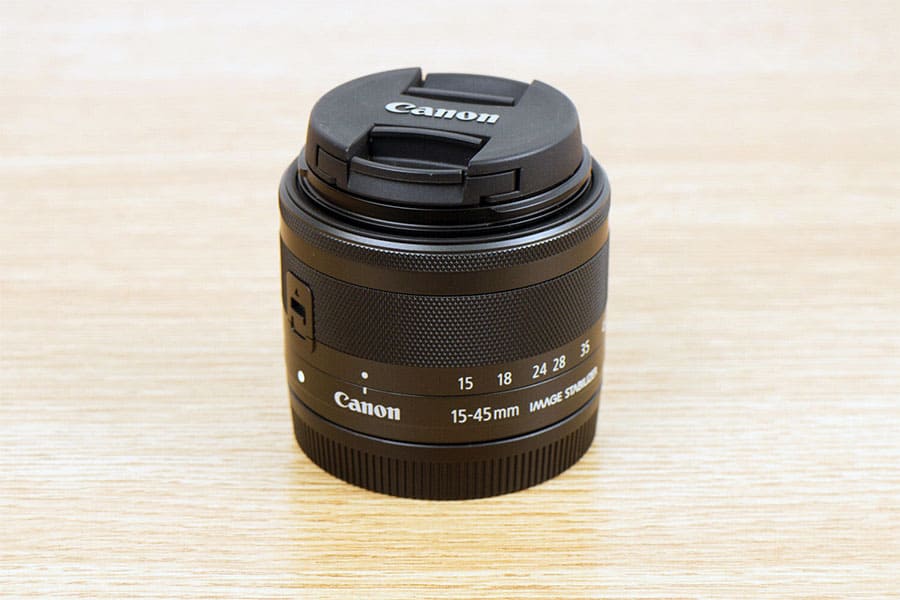
The flipside to this is that people don’t spend much time talking about those boring workaday lenses with dreary specs that we rely upon to produce 99% of our photography.
Canon’s EF-M 15-45mm f/3.5-6.3 is just such a lens. A common or garden zoom that not only covers moderate wide angle settings, but also the short end of the telephoto range.
Its wide angle credentials are solid; starting at a respectable 15mm, which is equivalent to 24mm on full frame. That’s plenty wide enough for most uses.
Yet the fact that its range stretches all the way through to portrait length, rather than making the lens even more appealing, somehow just seems to reduce its charm instead. It feels like a jack of all trades.
In short, this is not a sexy lens. It has no charisma. No sparkle. It gets ignored at parties, while the less versatile but more showy bits of glass bask in all the attention.
True, considering that the already uninspiring maximum aperture of f/3.5 drops even further to f/6.3 as you move through the zoom range, this is not a lens to get too many people salivating.
And few photographers’ nether regions will start tingling at the prospect of an all-plastic build either.
But the EF-M 15-45mm f/3.5-6.3 is a highly dependable companion; few will have cause to complain about its autofocusing abilities.
It’s a faithful partner capable of delivering good quality images, too. And at a variety of zoom settings – both wide and narrow – with little in the way of optical flaws.
What’s more, with built-in IS, this lens is nothing if not stable; no unpredictable moodiness or hair-raising tantrums here.
So ask yourself, who would you rather wake up next to ten years from now?
– A flashy show-off who spends most of the time in the bottom of the camera bag doing nothing, claiming that the situation just isn’t right for its talents?
– An honest, quiet, hardworking, dependable companion who produces good quality images in a wide range of shooting situations (and who has finally learned to put the toilet seat down after use)?
What to Look For When Choosing a Wide Angle Lens for the Canon M50
Maximum Aperture
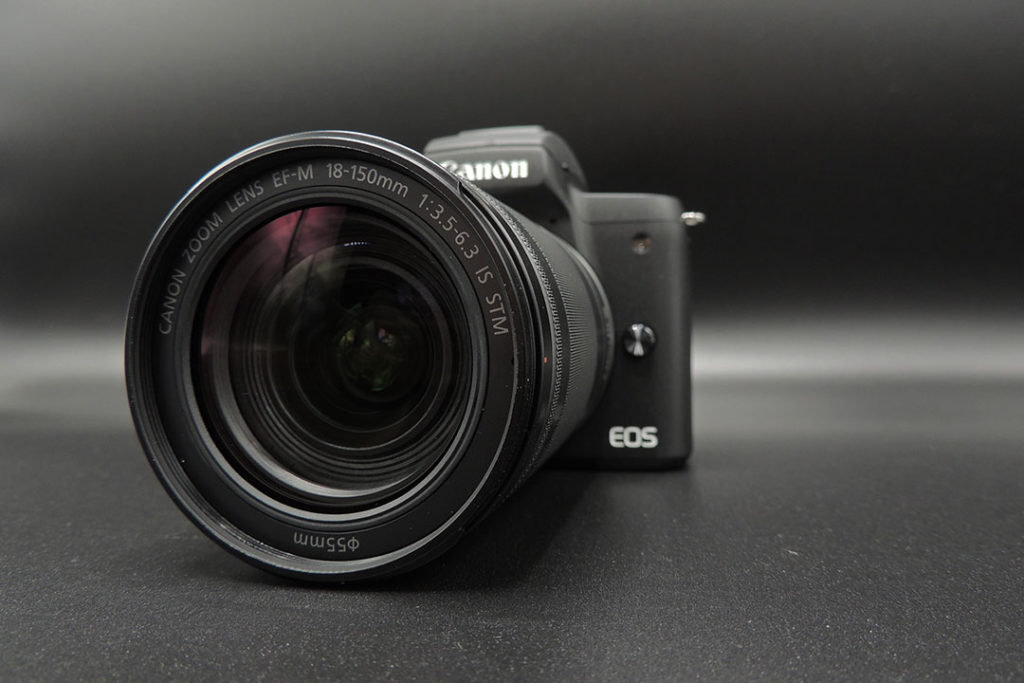
The wider a lens diaphragm can open, the more light can enter through it. Capturing more light offers a number of potential advantages.
For example, it may allow you to use a faster shutter speed in order to freeze action and avoid camera shake. Or you can use a lower ISO in order to reduce digital noise.
But using a wider aperture will also result in a shallower depth-of-field. Some photographers will consider this an advantage.
As an example, because a shallow depth-of-field is an excellent way of isolating the subject from its background, wide aperture lenses are very popular for portraiture.
But others will try to avoid a shallow depth-of-field at all costs; landscape photographers generally require a very deep depth-of-field, in order to sharply capture the entire scene in great detail from foreground to background.
Some photographers – those shooting the night sky, or doing documentary work, to name but a couple – are willing to pay vast sums of money just to get an extra stop or two of light onto their image sensor.
For others – landscape photographers in particular – this would be madness, as any aperture setting faster than f/8 is unlikely to ever get used anyway.
The above is a summary of how maximum aperture affects depth-of-field in general, and should be taken into account when considering purchasing a lens of any kind.
However, while these rules also hold true for wide angle lenses, they do so to a slightly lesser degree than for longer lenses.
This is because the wider the lens focal length, the more difficult it becomes to produce a narrow depth-of-field.
Certainly nobody buys a 20mm lens expecting to get huge separation between subject and background.
But at 35mm or, even 28mm, some blurring of the background can certainly be achieved at wider apertures. In short, the wider the focal length, the less a fast maximum aperture will have a noticeable impact on depth-of-field.
However, the rules regarding light-gathering abilities remain constant at all focal lengths.
So if you see yourself spending much time shooting in low light, then by all means seek out a faster lens. Just keep in mind that the faster the glass, the higher the asking price is likely to be.
Bokeh
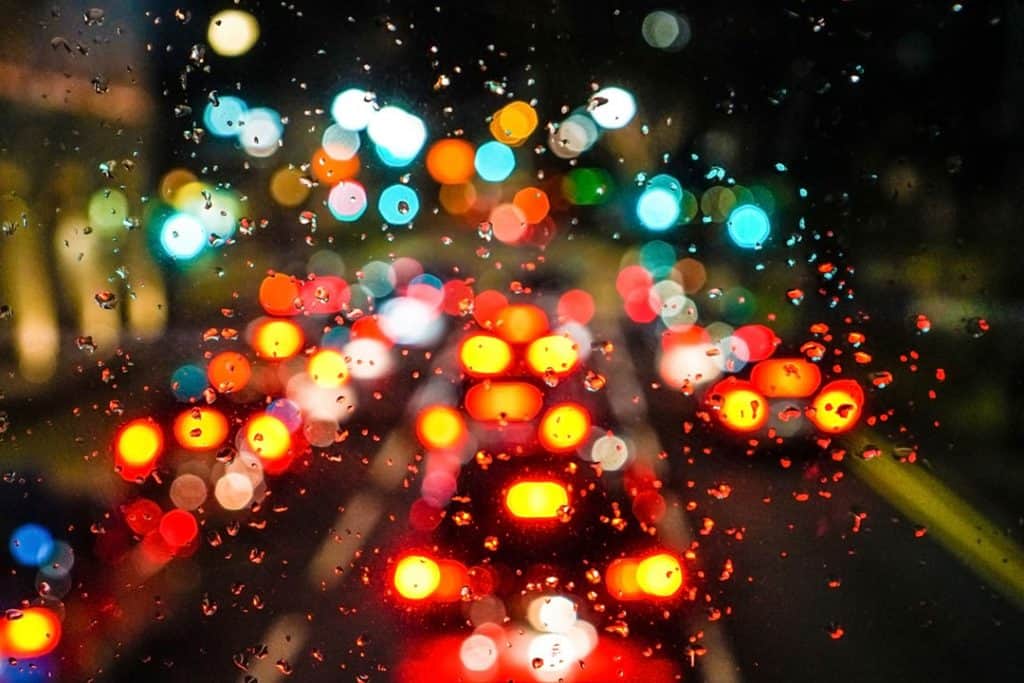
The word bokeh refers to the way in which a given lens renders out of focus areas of an image.
However, just keep in mind that bokeh is more about the look of out of focus areas than the degree to which they are defocussed.
As we’ve just noted, it can be difficult to get much of an image out of focus when using a wide angle lens.
Particularly beyond a certain focal length. And if all the background is more or less sharply focused, then clearly bokeh becomes a somewhat moot subject.
Nonetheless, a more moderate wide angle lens will allow for a degree of background blur. Especially if it offers fast apertures and is capable of focusing on subjects very close up.
When it comes to wide angle lenses, then, we can say that there’s a sliding scale of importance that should be given to bokeh.
At one extreme there are photos taken on a very wide angle lens, using a small aperture, with the camera not too close to the subject. This basically describes most landscape photographs.
Here practically the entire image will be in focus, and thus bokeh will be of no importance whatsoever.
At the other end of the scale are shots taken on a more moderate wide angle lens, using a wider aperture, and with the camera positioned closer to the subject.
This could describe any number of shooting situations, in a variety of genres (other than landscape photography). And here more attention should be given to bokeh.
Bokeh is highly subjective. Some people like the blurred areas of an image to be soft, smooth, and essentially unnoticeable. Others enjoy a very dramatic swirly bokeh effect.
However, most people agree that defocused areas that are too busy looking, or feature optical defects known as cats eyes and onion rings, can be distracting.
There’s no way to predict what kind of bokeh a given lens will produce merely by looking at a technical spec sheet.
The proof, as it were, is in the pudding. If you’re considering purchasing a wide angle lens for your M50, and can imagine wanting to shoot images that feature a degree of blur, be sure to check out similar images produced with the lens in question to make sure that you like the look of its out of focus rendering.
Image Quality
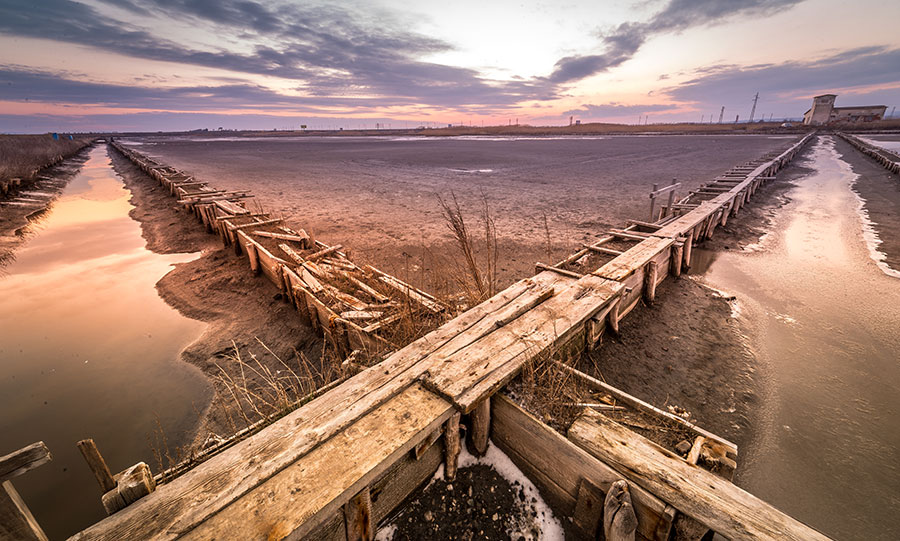
Let me start this section by saying that few modern lenses truly suck in terms of image quality.
There’s certainly a degree of variation between different brands and products, but very few lenses perform so badly on image quality that I’d recommended avoiding them altogether.
Nonethelss, if you’re in the market for a new lens, obviously image quality is a topic you’ll want to give some consideration to before parting with your hard earned money.
The good news is that wide angle lenses in general tend to be pretty sharp. And nearly all lenses will produce nicely resolved and detailed images when used stopped down a little.
Where you should play close attention to image sharpness, however, is when checking out how a lens behaves when used with its aperture wide-open.
Here many lenses will still perform excellently. At least at the center of the image. However, it’s quite common for even an otherwise optically superb lens to display a degree of softness towards the edges of the frame at wider apertures.
Nonetheless, this will usually clear up as you close down the diaphragm a little. In any case, for those shooting portraits and other genres where little of importance is likely to be placed at the edge of the frame anyway, corner softness is not really a major concern.
Beyond sharpness, the term image quality encompasses a whole bunch of other considerations too.
Some of which, such as color, are highly subjective. Whereas others are basically optical defects that pretty much any photographer would want to avoid.
In this last category we would probably include issues such as barrel distortion, vignetting, color fringing etc.
However, as unattractive as these defects can be, in general you should probably expect to see some degree of (one or more of) these problems with all but the most remarkable of lenses.
Still, as these annoyances can usually be corrected using software with only a minimum of fuss, mostly they are not a major cause for concern (note, however, that some types of color fringing can be more troublesome).
Focal Length

This is a guide to wide angle lenses for the M50.
So we can take it for granted that the range of focal lengths under consideration is somewhat limited. I.e., nothing over what would be equivalent to about a 35mm lens on full frame (and some photographers might not even consider this focal length to be a true wide angle lens anyway).
Yet there’s considerable variation in just how wide a wide angle lens can be.
A 35mm (equivalent) lens is only moderately wide. It will allow you to capture more of a scene than a standard lens, without the need to step back further in order to fit everything in – which in some cases won’t be possible anyway, due to physical obstacles in the environment; such as walls.
But a 35mm lens won’t be wide enough for certain shooting situations. Nor can it offer the same dramatic perspective as will be created by a much wider lens.
With that said, the dramatic point of view produced by a wider lens – say a 28mm (equivalent) and beyond – comes with some pretty noticeable perspective distortion.
This will make objects close to the lens appear huge, while those even slightly further away will appear relatively tiny.
When using such a lens, you’ll need to be pretty close to your subject if it isn’t to become lost in the frame.
But this isn’t a tactic that works particularly well if your subject happens to be a person, By shooting so close, their facial features are going to end up distorted like a caricature.
Giving your subjects bulging eyes, a gigantic forehead, or a bulbous nose can be amusing for all of about three seconds, but the novelty soon wears off. Especially for the subject.
Even if your subject is of a kind unlikely to complain about being unflatteringly photographed – say a building, for example – you’ll need to be shooting from a precisely square-on position, or you’ll end up with all your horizontal and/or vertical lines distorted.
Sometimes this distortion can make for a dynamic effect; in street photography, for example, when you want to create a feeling of energy and movement. Mostly though it will just look amateurish and untidy.
Ultrawide angle lenses – say those wider than 20mm (equivalent) – suffer from these problems even more than usual.
Buy they also tend to be used in situations where such problems are less likely to occur; shooting the Milky Way, say, or when capturing a broad vista of a rural landscape. Here the photographer will be positioned too far from the subject for perspective distortion to be a real issue.
As you can see, then, not all wide angle lenses are appropriate for the same tasks. Ones at the widest end of the spectrum tend to be useful in rather specific shooting situations only.
Yet some photographers spend their entire careers shooting in no other situations but these. That might be you too.
For more general day-to-day shooting in a variety of conditions, however, a moderate wide angle lens of around 28mm to 35mm (equivalent) will likely prove much more versatile.
In any case, should you need to get more in the frame, most of the time you’ll be able to simply step back from the scene.
Just keep in mind that this is less likely to be true when photographing indoors, where dividing walls may make using anything but an ultrawide angle lens impractical.
Image Stabilization
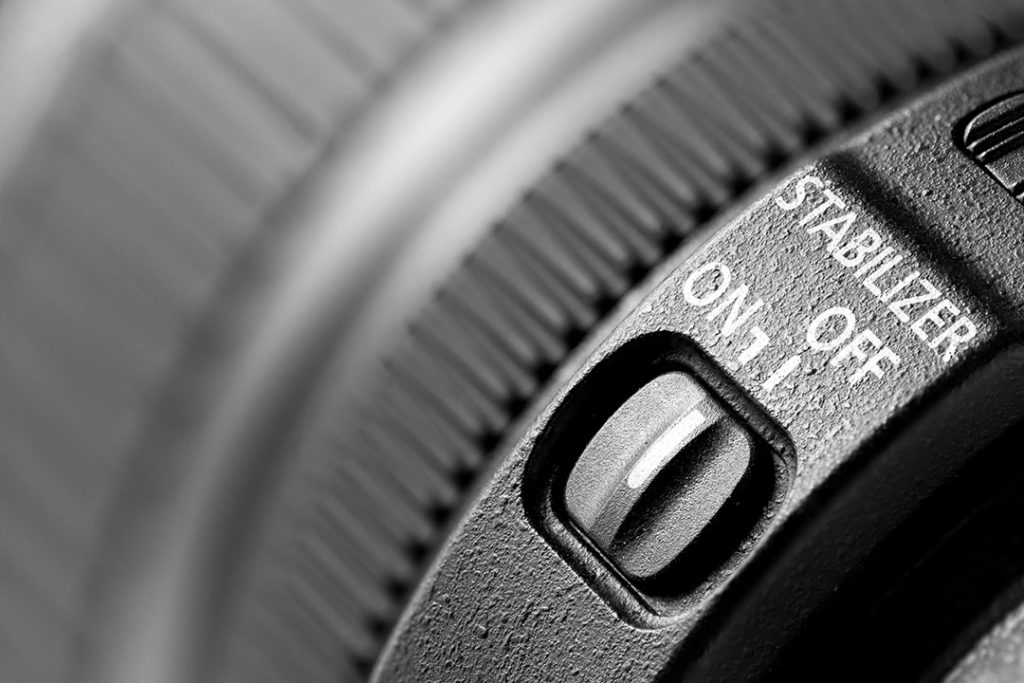
Image stabilization can be very handy. Particularly in certain shooting conditions; when there’s little light for example, or when filming video clips handheld.
The thing is, though, as a Canon M50 owner you already have image stabilization in the camera body.
And from what I’ve seen, the addition of in-lens stabilization does very little to improve the already great performance of the M50’s IS system.
But there’s another consideration; camera shake is most noticeable when using longer focal length lenses.
It’s like standing in a skyscraper during an earthquake; you will probably feel some vibration no matter where in the building you may be located, but you can bet that only those on the top floors will feel the building sway from side to side.
Yet this is a guide to wide angle lenses. To continue the earthquake metaphor, that’s like standing in the basement.
If you plan on doing a lot of handheld video work without a gimbal, then yes I can see that it might be worth seeking out a lens with built-in IS to augment that already offered by the M50 body.
For anyone else though, I would argue that image stabilization is a very minor consideration that shouldn’t be allowed to influence your decision too much.
If you opt for a lens that coincidentally also has IS; great, enjoy the extra peace of mind that this brings. But for most photographers, choosing a wide angle lens with this feature probably shouldn’t be top priority.
Prime vs Zoom
Zooms are great. They provide a variety of focal lengths in a single handy lens.
Why wouldn’t you choose a wide angle zoom over a boring old prime lens?
Well, there are several good reasons actually.
Zooms are convenient in many ways, for sure. But they typically come with a number of compromises, too.
For one, zooms tend to have slower maximum apertures than comparable prime lenses.
Not always, but often. This is true of zoom lenses for all camera makes and models. But it’s especially true of zooms for the Canon M50.
In any case, even if you do find a fast wide angle zoom that fits your needs, you can expect to pay a lot more for it than you would for a similarly specced prime.
What’s more, the chances of your zoom offering the same image quality as an equally priced prime lens are fairly low.
Again, not impossible – there are some very good zooms around, especially if you are willing to pay dearly – but not all that likely.
But yes, despite all this, zooms really are great; you just throw a single lens in your bag where you would otherwise need to carry three or more primes in order to cover the same range of focal lengths. For many photographers this will be an advantage that trumps all others.
In short, both options offer their respective pros and cons. Only you can decide which is right for your photography.
Resources
Final Thoughts
Even after several years on the market, the range of wide angle lenses available for the Canon M50 remains fairly limited. At least if you stick purely to Canon’s own offerings.
Thankfully, though, a number of very reputable third-party brands have stepped in to fill this gap, producing some excellent wide angle lenses that come with a mount for the Canon M-series already installed.
In particular, photographers looking for faster maximum apertures than the average canon M-mount lens can provide will probably want to explore options from brands such as Samyang, Sigma, and Venus Optics.
The one potential drawback among these manufacturers, however, is a general aversion to autofocus.
Nonetheless, no matter your photographic needs, hopefully you’ve found something among my guide to the best wide angle lenses for the Canon M50 that exactly suits your requirements.

